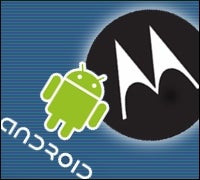 |
Motorola is slated to give the world a first look at its upcoming portfolio of Android-based smartphones, which the slumping mobile provider is betting will bring holiday cheer in the form of a significant spike in sales later this year.
Invitations to a Sept. 10 press event bearing the Android logo went out to the media today, but so far, Motorola is revealing little else.
“We will be making news on our Android portfolio in San Francisco on Sept. 10,” a Motorola spokesperson told InternetNews.com.
Given the sparse details, it is widely expected that Motorola will announce model specifications — and perhaps pricing and carriers — at the event, with Android phones hitting store shelves as soon as October.
According to recent leaks, Motorola, along with U.S. carrier Verizon Wireless, are expected to begin offering a handset codenamed “Sholes,” which could be the first Android-powered smartphone for Verizon. Reports suggest that the device could cost $199 and boast a 5-megapixel camera and 3.7-inch touchscreen.
The launch will mark a key step in Motorola’s effort to reinvent itself as a viable contender in the lucrative smartphone market — an effort it sees hinging chiefly on a new lineup of phones built on the open source Android platform.
The news comes at a time when smartphones sales are surging amid a wider handset slump. Motorola, however, has not had a breakthrough hit in years and remained relatively stagnant in the smartphone space, even as rivals continue innovating.
Palm (NASDAQ: PALM) in early June released its long-awaited Pre smartphone, running on the nascent webOS platform. It’s also rumored to be developing a lower-cost version of the Pre, dubbed Pixie. On the developer front, Palm also just released the webOS SDK and is beta testing e-commerce components of its new app store.
Apple (NASDAQ: AAPL), which released the iPhone 3G S on June 16, followed up a day later with the upgrade to version 3.0 of the OS. Its next update, 3.1, is expected in September.
BlackBerry maker Research In Motion (NASDAQ: RIMM) has also been busy. It will soon be rolling out its answer to the iPhone 3GS, the Storm 2, and is joining Verizon in opening a mobile app store later this year.
RIM also this week bought an open source mobile browser company, Torch Mobile, in the first step toward introducing a new browser in 2010 aimed squarely at the WebKit-based browsers offered by Apple and Google.
Android ahead
Motorola’s not the only handset maker wagering on Android. Samsung released its first Android smartphone, the I7500, in April. PC maker Acer is also expected to ship a model based on the open source software.
Verizon’s addition to Android’s sellers in the U.S. will also give the software a bump. Currently, T-Mobile is the sole carrier for Android-powered phones, offering the HTC T-Mobile G1, which went on sale last year, and the recently launched myTouch 3G.
So far, however, Android has yet to make a huge dent in the market.
Industry researcher Gartner earlier this month said that Nokia’s Symbian controls 51 percent of the smartphone OS market worldwide, while the BlackBerry and Apple iPhone claim 18 percent and 13 percent, respectively. Android’s share is far lower, at about 1.8 percent.
Yet Gartner also pointed to the surge of activity around Android coming later this year as a likely sign of future growth.
In addition to models from Motorola, Samsung and others, that activity includes an array of new software updates. For instance, Reports have speculated that Motorola’s Sholes will run on version 2.0 of Android, a release dubbed “Éclair”.
Éclair would mark only the latest in Android’s aggressive release schedule. The first major upgrade to the software took place in May, with “Cupcake”, which upped Android to version 1.5.
Since then, Google (NASDAQ: GOOG), Android’s chief backer, has also said that Éclair is on the way, to be followed by “Flan” — but has not said when either update would officially debut.


